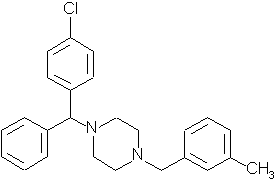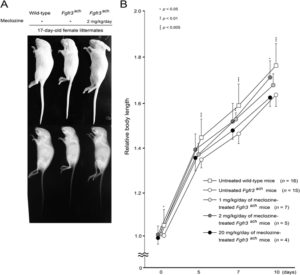Achondroplasia Treatment and Increase Height Using Meclozine aka Meclizine – Great News For Parents!
 We have already talked about the chemical BMN-111 by Biomarin which is supposed to be able to treat young children with open growth plate cartilage suffering from Achondroplasia. Achondroplasia is the most common type of skeletal disorder which causes people to end up with abnormally short stature, often below the dwarf/small people height of 4′ 10″.
We have already talked about the chemical BMN-111 by Biomarin which is supposed to be able to treat young children with open growth plate cartilage suffering from Achondroplasia. Achondroplasia is the most common type of skeletal disorder which causes people to end up with abnormally short stature, often below the dwarf/small people height of 4′ 10″.
Now there seems to be another chemical treatment that has been proven to have benefits to help treat achondroplasia by inhibiting the FGFR3 gene abnormality. This compound is called Meclozine or Meclizine.
Refer to the study…
From the abstract…
“….We used the C-natriuretic peptide (CNP) as a potent inhibitor of the FGFR3 signaling throughout our experiments, and found that meclozine was as efficient as CNP in attenuating the abnormal FGFR3 signaling. We propose that meclozine is a potential therapeutic agent for treating ACH and other FGFR3-related skeletal dysplasias“
We’ve seen already at least 1 Patent (by Nakao) filed which was used to treat idiopathic short stature using a type of C-natruretic peptide (CNP). This compound seems to work just as well for skeletal dysplasia as any of the CNP derivative types.
For more information on Meclozine/Meclizine, refer to its Wikipedia article here.
From the article, all these brand name pills have as the active ingredient meclizine inside…
- Bonine
- Bonamine
- Antivert
- Postafen
- Sea Legs
- Dramamine (Less Drowsy Formulation)
- Emesafene
On its Wikipedia page, it says that this compound is supposed to be used for motion sickness, but has dementia enhancing effects on older people.
The conclusion made by that researchers are the following…
“We found that meclozine dihydrochloride, a commonly used anti-emetic drug for its anti-histamine activity, efficiently suppresses FGFR3 signaling in three different chondrocytic cell lines and embryonic bone organ culture. We also identified that meclozine suppresses FGF2-mediated phosphorylation of ERK”
“Achondroplasia (ACH) is the most common short-limbed skeletal dysplasia caused by gain-of-function mutations in the fibroblast growth factor receptor 3 (FGFR3). No effective FGFR3-targeted therapies for ACH are currently available. By drug repositioning strategies, we identified that meclozine, which has been used as an anti-motion-sickness, suppressed FGFR3 signaling in chondrocytes and rescued short-limbed phenotype in ACH mouse model. Here, we conducted various pharmacological tests for future clinical application in ACH. Pharmacokinetic analyses demonstrated that peak drug concentration (Cmax) and area under the concentration-time curve (AUC) of 2 mg/kg of meclozine to mice was lower than that of 25 mg/body to human, which is a clinical usage for anti-motion-sickness. Pharmacokinetic simulation studies showed that repeated dose of 2 mg/kg of meclozine showed no accumulation effects. Short stature phenotype in the transgenic mice was significantly rescued by twice-daily oral administration of 2 mg/kg/day of meclozine. In addition to stimulation of longitudinal bone growth, bone volume and metaphyseal trabecular bone quality were improved by meclozine treatment. We confirmed a preclinical proof of concept for applying meclozine for the treatment of short stature in ACH, although toxicity and adverse events associated with long-term administration of this drug should be examined.”
“Twice-daily oral administration of 1 and 2 mg/kg/day of meclozine reverses the dwarfed phenotype in Fgfr3 ach mice. (A) A representative image of the individual female littermates at the end of treatment demonstrated that an untreated Fgfr3 ach mouse reveled the dwarfed phenotype, which was rescued by oral administration of 2 mg/kg/day of meclozine treatment. (B) Relative body length of the wild-type mice and Fgfr3 ach mice was calculated based on the body length of untreated Fgfr3 ach mice at 0 day. The body length of 1 or 2 mg/kg/day of meclozine-treated Fgfr3 ach mice was larger than that of untreated Fgfr3 ach mice throughout the treatment period. On the other hand, 20 mg/kg/day of meclozine-treated Fgfr3 ach mice were not larger than untreated Fgfr3 ach mice at the end of treatment. Mean and SD are indicated. Statistical significance was analyzed by the unpaired t test for each dose of meclozine-treated Fgfr3 ach mice (n = 7, 5, and 4 for 1, 2, and 20 mg/kg/day of meclozine, respectively) or untreated wild-type mice (n = 16) versus untreated Fgfr3 ach mice (n = 15).”
Interesting that the higher dose did not help to increase length. This could be why it’s so hard for meclizine to be effective in humans. There’s an equilibrium dosage that’s hard to pinpoint.
Warning: We are not doctors or medical professionals. We would like to tell any parents of kids suffering from Achondroplasia/Short Stature to NOT just go down to the local drugstore and buying bucket-loads of Dramamine, the Less Drowsy Formulation, to try to treat/inhibit/suppress the FGFR3 abnormality. Please seek professional advice first before going off and try to make your children taller.

